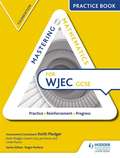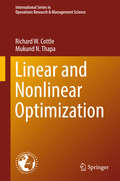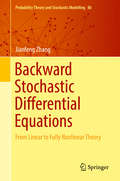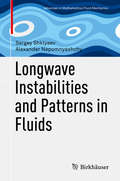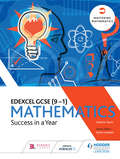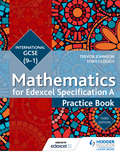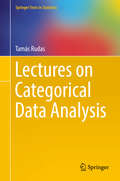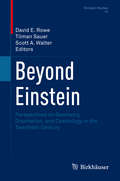- Table View
- List View
Free Probability and Random Matrices (Fields Institute Monographs #35)
by James A. Mingo Roland SpeicherThis volume opens the world of free probability to a wide variety of readers. From its roots in the theory of operator algebras, free probability has intertwined with non-crossing partitions, random matrices, applications in wireless communications, representation theory of large groups, quantum groups, the invariant subspace problem, large deviations, subfactors, and beyond. This book puts a special emphasis on the relation of free probability to random matrices, but also touches upon the operator algebraic, combinatorial, and analytic aspects of the theory. The book serves as a combination textbook/research monograph, with self-contained chapters, exercises scattered throughout the text, and coverage of important ongoing progress of the theory. It will appeal to graduate students and all mathematicians interested in random matrices and free probability from the point of view of operator algebras, combinatorics, analytic functions, or applications in engineering and statistical physics.
Mastering Mathematics for WJEC GCSE Practice Book: Foundation
by Keith Pledger Gareth Cole Joe Petran Linda MasonExam Board: WJECLevel: GCSESubject: MathematicsFirst Teaching: September 2015First Exam: Summer 2017Provide structured support and extra practice with differentiated questions that focus on reasoning and problem-solving building the exam skills needed to succeed in the new GCSE specifications; developed by a team of expert authors with examining experience.- Develops confidence and supports independent learning with graduated exercises for each unit.- Builds fluency, problem-solving and reasoning skills with exam-style questions that build on previous learning.- Provides full coverage of the GCSE grade range with three books - matching the student books - meaning that content is focused at the right level for each student.
Recent Progress and Modern Challenges in Applied Mathematics, Modeling and Computational Science (Fields Institute Communications #79)
by Roderick Melnik Roman Makarov Jacques BelairThis volume is an excellent resource for professionals in various areas of applications of mathematics, modeling, and computational science. It focuses on recent progress and modern challenges in these areas. The volume provides a balance between fundamental theoretical and applied developments, emphasizing the interdisciplinary nature of modern trends and detailing state-of-the-art achievements in Applied Mathematics, Modeling, and Computational Science. The chapters have been authored by international experts in their respective fields, making this book ideal for researchers in academia, practitioners, and graduate students. It can also serve as a reference in the diverse selected areas of applied mathematics, modelling, and computational sciences, and is ideal for interdisciplinary collaborations.
Divergence Operator and Related Inequalities (SpringerBriefs in Mathematics)
by Gabriel Acosta Ricardo G. DuránThis Brief is mainly devoted to two classical and related results: the existence of a right inverse of the divergence operator and the so-called Korn Inequalities. It is well known that both results are fundamental tools in the analysis of some classic differential equations, particularly in those arising in fluid dynamics and elasticity. Several connections between these two topics and improved Poincaré inequalities are extensively treated. From simple key ideas the book is growing smoothly in complexity. Beginning with the study of these problems on star-shaped domains the arguments are extended first to John domains and then to Hölder α domains where the need of weighted spaces arises naturally. In this fashion, the authors succeed in presenting in an unified and concise way several classic and recent developments in the field. These features certainly makes this Brief useful for students, post-graduate students, and researchers as well.
Convexity and Concentration (The IMA Volumes in Mathematics and its Applications #161)
by Eric Carlen Mokshay Madiman Elisabeth M. WernerThis volume presents some of the research topics discussed at the 2014-2015 Annual Thematic Program Discrete Structures: Analysis and Applications at the Institute of Mathematics and its Applications during the Spring 2015 where geometric analysis, convex geometry and concentration phenomena were the focus. Leading experts have written surveys of research problems, making state of the art results more conveniently and widely available. The volume is organized into two parts. Part I contains those contributions that focus primarily on problems motivated by probability theory, while Part II contains those contributions that focus primarily on problems motivated by convex geometry and geometric analysis. This book will be of use to those who research convex geometry, geometric analysis and probability directly or apply such methods in other fields.
CCEA GCSE Mathematics Foundation (2nd Edition) (PDF)
by Neill Hamilton Rosie McCreaBuild all the necessary skills to progress your students' learning and develop their problem-solving skills with this fully updated edition of the market-leading Student's Book for CCEA GCSE Mathematics. - Supports you and your students through the new specifications with content mapped to the new module options with material for each module (M1/M5, M2/M6 F or M3/M7 and M4/M8 H) clearly indicated throughout. - Prepares students for assessment with plenty of practice questions divided into calculator and non-calculator, plus links to further relevant and appropriate exam questions.- Develops understanding with Learning Objectives and required knowledge set out at the start of each chapter.- Tests understanding with end of chapter exercises and problem-solving questions throughout. - Enhances learning with detailed worked examples and solutions.
CCEA GCSE Mathematics Foundation Practice Book (2nd Edition) (PDF)
by Linda Liggett Robin LiggettExam Board: CCEALevel: GCSESubject: MathematicsFirst Teaching: September 2017First Exam: Summer 2019Provide structured support and extra practice with hundreds of practice questions that focus on problem-solving, building the exam skills needed to succeed in the new GCSE specifications. - Enhance learning and build exam skills with extra practice designed to support the student books- Help develop students' skills and prepare them effectively for their exam with questions that cover all units of the new syllabus- Build problem-solving and mathematical reasoning skills with a range of practice questions
CCEA GCSE Mathematics Higher (2nd Edition) (PDF)
by Neill Hamilton Anne ConnollyBuild all the necessary skills to progress your students' learning and develop their problem-solving skills with this fully updated edition of the market-leading Student's Book for CCEA GCSE Mathematics. - Supports you and your students through the new specifications with content mapped to the new module options with material for each module (M1/M5, M2/M6 F or M3/M7 and M4/M8 H) clearly indicated throughout. - Prepares students for assessment with plenty of practice questions divided into calculator and non-calculator, plus links to further relevant and appropriate exam questions.- Develops understanding with Learning Objectives and required knowledge set out at the start of each chapter.- Tests understanding with end of chapter exercises and problem-solving questions throughout. - Enhances learning with detailed worked examples and solutions.
CCEA GCSE Mathematics Higher Practice Book (2nd Edition) (PDF)
by Anne Connolly Linda Liggett Robin LiggettExam Board: CCEALevel: GCSESubject: MathematicsFirst Teaching: September 2017First Exam: June 2019Provide structured support and extra practice with hundreds of practice questions that focus on problem-solving, building the exam skills needed to succeed in the new GCSE specifications. - Enhance learning and build exam skills with extra practice designed to support the student books- Help develop students' skills and prepare them effectively for their exam with questions that cover all units of the new syllabus- Build problem-solving and mathematical reasoning skills with a range of practice questions
Matrix-Exponential Distributions in Applied Probability (Probability Theory and Stochastic Modelling #81)
by Mogens Bladt Bo Friis NielsenThis book contains an in-depth treatment of matrix-exponential (ME) distributions and their sub-class of phase-type (PH) distributions. Loosely speaking, an ME distribution is obtained through replacing the intensity parameter in an exponential distribution by a matrix. The ME distributions can also be identified as the class of non-negative distributions with rational Laplace transforms. If the matrix has the structure of a sub-intensity matrix for a Markov jump process we obtain a PH distribution which allows for nice probabilistic interpretations facilitating the derivation of exact solutions and closed form formulas. The full potential of ME and PH unfolds in their use in stochastic modelling. Several chapters on generic applications, like renewal theory, random walks and regenerative processes, are included together with some specific examples from queueing theory and insurance risk. We emphasize our intention towards applications by including an extensive treatment on statistical methods for PH distributions and related processes that will allow practitioners to calibrate models to real data. Aimed as a textbook for graduate students in applied probability and statistics, the book provides all the necessary background on Poisson processes, Markov chains, jump processes, martingales and re-generative methods. It is our hope that the provided background may encourage researchers and practitioners from other fields, like biology, genetics and medicine, who wish to become acquainted with the matrix-exponential method and its applications.
Linear and Nonlinear Optimization (International Series in Operations Research & Management Science #253)
by Richard W. Cottle Mukund N. ThapaThis textbook on Linear and Nonlinear Optimization is intended for graduate and advanced undergraduate students in operations research and related fields. It is both literate and mathematically strong, yet requires no prior course in optimization. As suggested by its title, the book is divided into two parts covering in their individual chapters LP Models and Applications; Linear Equations and Inequalities; The Simplex Algorithm; Simplex Algorithm Continued; Duality and the Dual Simplex Algorithm; Postoptimality Analyses; Computational Considerations; Nonlinear (NLP) Models and Applications; Unconstrained Optimization; Descent Methods; Optimality Conditions; Problems with Linear Constraints; Problems with Nonlinear Constraints; Interior-Point Methods; and an Appendix covering Mathematical Concepts. Each chapter ends with a set of exercises. The book is based on lecture notes the authors have used in numerous optimization courses the authors have taught at Stanford University. It emphasizes modeling and numerical algorithms for optimization with continuous (not integer) variables. The discussion presents the underlying theory without always focusing on formal mathematical proofs (which can be found in cited references). Another feature of this book is its inclusion of cultural and historical matters, most often appearing among the footnotes."This book is a real gem. The authors do a masterful job of rigorously presenting all of the relevant theory clearly and concisely while managing to avoid unnecessary tedious mathematical details. This is an ideal book for teaching a one or two semester masters-level course in optimization – it broadly covers linear and nonlinear programming effectively balancing modeling, algorithmic theory, computation, implementation, illuminating historical facts, and numerous interesting examples and exercises. Due to the clarity of the exposition, this book also serves as a valuable reference for self-study." Professor Ilan Adler,IEOR Department,UC Berkeley"A carefully crafted introduction to the main elements and applications of mathematical optimization. This volume presents the essential concepts of linear and nonlinear programming in an accessible format filled with anecdotes, examples, and exercises that bring the topic to life. The authors plumb their decades of experience in optimization to provide an enriching layer of historical context. Suitable for advanced undergraduates and masters students in management science, operations research, and related fields."Michael P. Friedlander,IBM Professor of Computer Science,Professor of Mathematics,University of British Columbia
Dynamic Data Analysis: Modeling Data with Differential Equations (Springer Series in Statistics)
by James Ramsay Giles HookerThis text focuses on the use of smoothing methods for developing and estimating differential equations following recent developments in functional data analysis and building on techniques described in Ramsay and Silverman (2005) Functional Data Analysis. The central concept of a dynamical system as a buffer that translates sudden changes in input into smooth controlled output responses has led to applications of previously analyzed data, opening up entirely new opportunities for dynamical systems. The technical level has been kept low so that those with little or no exposure to differential equations as modeling objects can be brought into this data analysis landscape. There are already many texts on the mathematical properties of ordinary differential equations, or dynamic models, and there is a large literature distributed over many fields on models for real world processes consisting of differential equations. However, a researcher interested in fitting such a model to data, or a statistician interested in the properties of differential equations estimated from data will find rather less to work with. This book fills that gap.
Deterministic Global Optimization: An Introduction to the Diagonal Approach (SpringerBriefs in Optimization)
by Yaroslav D. Sergeyev Dmitri E. KvasovThis book begins with a concentrated introduction into deterministic global optimization and moves forward to present new original results from the authors who are well known experts in the field. Multiextremal continuous problems that have an unknown structure with Lipschitz objective functions and functions having the first Lipschitz derivatives defined over hyperintervals are examined. A class of algorithms using several Lipschitz constants is introduced which has its origins in the DIRECT (DIviding RECTangles) method. This new class is based on an efficient strategy that is applied for the search domain partitioning. In addition a survey on derivative free methods and methods using the first derivatives is given for both one-dimensional and multi-dimensional cases. Non-smooth and smooth minorants and acceleration techniques that can speed up several classes of global optimization methods with examples of applications and problems arising in numerical testing of global optimization algorithms are discussed. Theoretical considerations are illustrated through engineering applications. Extensive numerical testing of algorithms described in this book stretches the likelihood of establishing a link between mathematicians and practitioners. The authors conclude by describing applications and a generator of random classes of test functions with known local and global minima that is used in more than 40 countries of the world. This title serves as a starting point for students, researchers, engineers, and other professionals in operations research, management science, computer science, engineering, economics, environmental sciences, industrial and applied mathematics to obtain an overview of deterministic global optimization.
Backward Stochastic Differential Equations: From Linear to Fully Nonlinear Theory (Probability Theory and Stochastic Modelling #86)
by Jianfeng ZhangThis book provides a systematic and accessible approach to stochastic differential equations, backward stochastic differential equations, and their connection with partial differential equations, as well as the recent development of the fully nonlinear theory, including nonlinear expectation, second order backward stochastic differential equations, and path dependent partial differential equations. Their main applications and numerical algorithms, as well as many exercises, are included. The book focuses on ideas and clarity, with most results having been solved from scratch and most theories being motivated from applications. It can be considered a starting point for junior researchers in the field, and can serve as a textbook for a two-semester graduate course in probability theory and stochastic analysis. It is also accessible for graduate students majoring in financial engineering.
Real Analysis: Series, Functions of Several Variables, and Applications (Undergraduate Texts in Mathematics #3)
by Miklós Laczkovich Vera T. Sós Gergely BálintThis book develops the theory of multivariable analysis, building on the single variable foundations established in the companion volume, Real Analysis: Foundations and Functions of One Variable. Together, these volumes form the first English edition of the popular Hungarian original, Valós Analízis I & II, based on courses taught by the authors at Eötvös Loránd University, Hungary, for more than 30 years. Numerous exercises are included throughout, offering ample opportunities to master topics by progressing from routine to difficult problems. Hints or solutions to many of the more challenging exercises make this book ideal for independent study, or further reading.Intended as a sequel to a course in single variable analysis, this book builds upon and expands these ideas into higher dimensions. The modular organization makes this text adaptable for either a semester or year-long introductory course. Topics include: differentiation and integration of functions of several variables; infinite numerical series; sequences and series of functions; and applications to other areas of mathematics. Many historical notes are given and there is an emphasis on conceptual understanding and context, be it within mathematics itself or more broadly in applications, such as physics. By developing the student’s intuition throughout, many definitions and results become motivated by insights from their context.
Applied Fourier Analysis: From Signal Processing to Medical Imaging
by Tim OlsonThe first of its kind, this focused textbook serves as a self-contained resource for teaching from scratch the fundamental mathematics of Fourier analysis and illustrating some of its most current, interesting applications, including medical imaging and radar processing. Developed by the author from extensive classroom teaching experience, it provides a breadth of theory that allows students to appreciate the utility of the subject, but at as accessible a depth as possible. With myriad applications included, this book can be adapted to a one or two semester course in Fourier Analysis or serve as the basis for independent study.Applied Fourier Analysis assumes no prior knowledge of analysis from its readers, and begins by making the transition from linear algebra to functional analysis. It goes on to cover basic Fourier series and Fourier transforms before delving into applications in sampling and interpolation theory, digital communications, radar processing, medical imaging, and heat and wave equations. For all applications, ample practice exercises are given throughout, with collections of more in-depth problems built up into exploratory chapter projects. Illuminating videos are available on Springer.com and Link.Springer.com that present animated visualizations of several concepts.The content of the book itself is limited to what students will need to deal with in these fields, and avoids spending undue time studying proofs or building toward more abstract concepts. The book is perhaps best suited for courses aimed at upper division undergraduates and early graduates in mathematics, electrical engineering, mechanical engineering, computer science, physics, and other natural sciences, but in general it is a highly valuable resource for introducing a broad range of students to Fourier analysis.
Finite Element Concepts: A Closed-Form Algebraic Development
by Gautam DasguptaThis text presents a highly original treatment of the fundamentals of FEM, developed using computer algebra, based on undergraduate-level engineering mathematics and the mechanics of solids. The book is divided into two distinct parts of nine chapters and seven appendices. The first chapter reviews the energy concepts in structural mechanics with bar problems, which is continued in the next chapter for truss analysis using Mathematica programs. The Courant and Clough triangular elements for scalar potentials and linear elasticity are covered in chapters three and four, followed by four-node elements. Chapters five and six describe Taig’s isoparametric interpolants and Iron’s patch test. Rayleigh vector modes, which satisfy point-wise equilibrium, are elaborated on in chapter seven along with successful patch tests in the physical (x,y) Cartesian frame. Chapter eight explains point-wise incompressibility and employs (Moore-Penrose) inversion of rectangular matrices. The final chapter analyzes patch-tests in all directions and introduces five-node elements for linear stresses. Curved boundaries and higher order stresses are addressed in closed algebraic form. Appendices give a short introduction to Mathematica, followed by truss analysis using symbolic codes that could be used in all FEM problems to assemble element matrices and solve for all unknowns. All Mathematica codes for theoretical formulations and graphics are included with extensive numerical examples.
Combinatorial Algebraic Geometry: Selected Papers From the 2016 Apprenticeship Program (Fields Institute Communications #80)
by Gregory G. Smith Bernd SturmfelsThis volume consolidates selected articles from the 2016 Apprenticeship Program at the Fields Institute, part of the larger program on Combinatorial Algebraic Geometry that ran from July through December of 2016. Written primarily by junior mathematicians, the articles cover a range of topics in combinatorial algebraic geometry including curves, surfaces, Grassmannians, convexity, abelian varieties, and moduli spaces. This book bridges the gap between graduate courses and cutting-edge research by connecting historical sources, computation, explicit examples, and new results.
New Trends in Approximation Theory: In Memory of André Boivin (Fields Institute Communications #81)
by Javad Mashreghi Myrto Manolaki Paul GauthierThe international conference entitled "New Trends in Approximation Theory" was held at the Fields Institute, in Toronto, from July 25 until July 29, 2016. The conference was fondly dedicated to the memory of our unique friend and colleague, André Boivin, who gave tireless service in Canada until his very last moment of his life in October 2014. The impact of his warm personality and his fine work on Complex Approximation Theory was reflected by the mathematical excellence and the wide research range of the 37 participants. In total there were 27 talks, delivered by well-established mathematicians and young researchers. In particular, 19 invited lectures were delivered by leading experts of the field, from 8 different countries. The wide variety of presentations composed a mosaic of aspects of approximation theory, highlighting interesting connections with important contemporary areas of Analysis. Primary topics discussed include application of approximation theory (isoperimetric inequalities, construction of entire order-isomorphisms, dynamical sampling); approximation by harmonic and holomorphic functions (especially uniform and tangential approximation), polynomial and rational approximation; zeros of approximants and zero-free approximation; tools used in approximation theory; approximation on complex manifolds, in product domains, and in function spaces; and boundary behaviour and universality properties of Taylor and Dirichlet series.
From Collective Beings to Quasi-Systems (Contemporary Systems Thinking)
by Gianfranco Minati Eliano PessaThis book outlines a possible future theoretical perspective for systemics, its conceptual morphology and landscape while the Good-Old-Fashioned-Systemics (GOFS) era is still under way. The change from GOFS to future systemics can be represented, as shown in the book title, by the conceptual change from Collective Beings to Quasi-systems. With the current advancements, problems and approaches occurring in contemporary science, systemics are moving beyond the traditional frameworks used in the past. From Collective Beings to Coherent Quasi-Systems outlines a conceptual morphology and landscape for a new theoretical perspective for systemics introducing the concept of Quasi-systems. Advances in domains such as theoretical physics, philosophy of science, cell biology, neuroscience, experimental economics, network science and many others offer new concepts and technical tools to support the creation of a fully transdisciplinary General Theory of Change. This circumstance requires a deep reformulation of systemics, without forgetting the achievements of established conventions. The book is divided into two parts. Part I, examines classic systemic issues from new theoretical perspectives and approaches. A new general unified framework is introduced to help deal with topics such as dynamic structural coherence and Quasi-systems. This new theoretical framework is compared and contrasted with the traditional approaches. Part II focuses on the process of translation into social culture of the theoretical principles, models and approaches introduced in Part I. This translation is urgent in post-industrial societies where emergent processes and problems are still dealt with by using the classical or non-systemic knowledge of the industrial phase.
Longwave Instabilities and Patterns in Fluids (Advances in Mathematical Fluid Mechanics)
by Sergey Shklyaev Alexander NepomnyashchyThis book summarizes the main advances in the field of nonlinear evolution and pattern formation caused by longwave instabilities in fluids. It will allow readers to master the multiscale asymptotic methods and become familiar with applications of these methods in a variety of physical problems. Longwave instabilities are inherent to a variety of systems in fluid dynamics, geophysics, electrodynamics, biophysics, and many others. The techniques of the derivation of longwave amplitude equations, as well as the analysis of numerous nonlinear equations, are discussed throughout. This book will be of value to researchers and graduate students in applied mathematics, physics, and engineering, in particular within the fields of fluid mechanics, heat and mass transfer theory, and nonlinear dynamics.
Edexcel GCSE Mathematics: Success in a Year (PDF)
by Heather DavisMotivate and re-engage students to succeed in Edexcel GCSE Maths 9-1 with this fresh and contemporary approach that blends classroom and independent learning and provides a tailor-made solution for every student, addressing misconceptions, tricky topics and exam technique. - Developed specifically for the new Edexcel GCSE 9-1 specification, this book offers a variety of targeted activities to engage and stimulate students to succeed in a year. - Presents strategies to help with problem-solving questions.- Highlights areas of weakness with diagnostic Skill Check questions that point to relevant sections within the book that can be revisited to reinforce learning.- Provides guidance on effective exam techniques designed to help consistently grow and develop independent learning.- Offers plenty of opportunities to test understanding with follow-up assessments at the end of each unit.- Equips you with a new approach presented in an informal style to help engage and motivate students.Secure success in a Year with:3 Exam practice papers69 'Do I know it now?' and 48 'Can I apply it now?' follow-up assessments - for students to test their knowledge and problem-solving skills45 Did you know? panels - show students the usefulness of the mathematics55 'What you need to know' summaries - provide the essential basics for each topic in an easy-to-use format70 'How to do it' panels - worked examples with solutions to enhance understanding of individual topics70 Learning Exercises - help students develop and practice their skills48 Problem-solving Exercises - offer students the opportunity to bring together their knowledge and problem solving skills in exam-style questions5 Problem-solving chapters dedicated to the key area of problem solving
Edexcel International GCSE (9-1) Mathematics Practice Book (3rd Edition) (PDF)
by Trevor Johnson Tony CloughEndorsed for Edexcel.Provide structured support and extra practice with a wealth of problem-solving and exam-style questions, in this fully updated edition written by an author team experienced in teaching and examining.- Enables students to maximise their grade potential and develop their exam skills with 700 exam-style questions.- Supports you and your students through the new specifications with over 100 additional questions addressing every part of the new syllabus such as the increase in Algebra.- Helps build problem-solving and mathematical reasoning skills with a dedicated chapter covering all topics and subject areas, with new questions to challenge the most able students.- Offers support for Higher tier students during their course and when revising for exams.
Lectures on Categorical Data Analysis (Springer Texts in Statistics)
by Tamás RudasThis book offers a relatively self-contained presentation of the fundamental results in categorical data analysis, which plays a central role among the statistical techniques applied in the social, political and behavioral sciences, as well as in marketing and medical and biological research. The methods applied are mainly aimed at understanding the structure of associations among variables and the effects of other variables on these interactions. A great advantage of studying categorical data analysis is that many concepts in statistics become transparent when discussed in a categorical data context, and, in many places, the book takes this opportunity to comment on general principles and methods in statistics, addressing not only the “how” but also the “why.” Assuming minimal background in calculus, linear algebra, probability theory and statistics, the book is designed to be used in upper-undergraduate and graduate-level courses in the field and in more general statistical methodology courses, as well as a self-study resource for researchers and professionals. The book covers such key issues as: higher order interactions among categorical variables; the use of the delta-method to correctly determine asymptotic standard errors for complex quantities reported in surveys; the fundamentals of the main theories of causal analysis based on observational data; the usefulness of the odds ratio as a measure of association; and a detailed discussion of log-linear models, including graphical models. The book contains over 200 problems, many of which may also be used as starting points for undergraduate research projects. The material can be used by students toward a variety of goals, depending on the degree of theory or application desired.
Beyond Einstein: Perspectives on Geometry, Gravitation, and Cosmology in the Twentieth Century (Einstein Studies #14)
by David E. Rowe Tilman Sauer Scott A. WalterBeyond Einstein: Perspectives on Geometry, Gravitation, and Cosmology explores the rich interplay between mathematical and physical ideas by studying the interactions of major actors and the roles of important research communities over the course of the last century.

